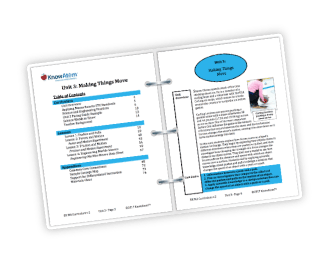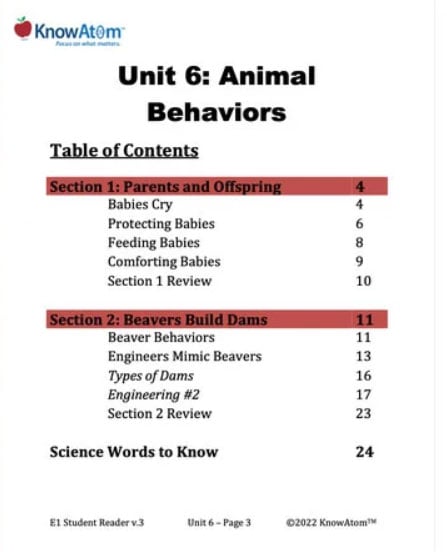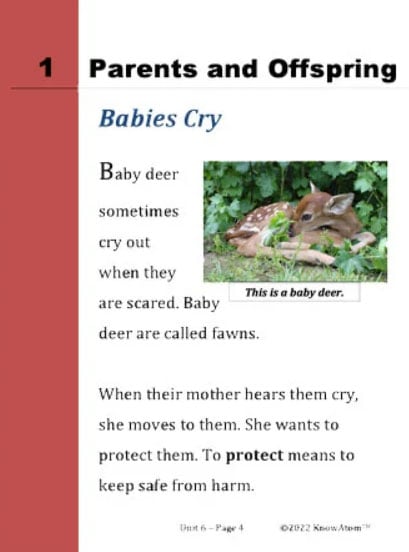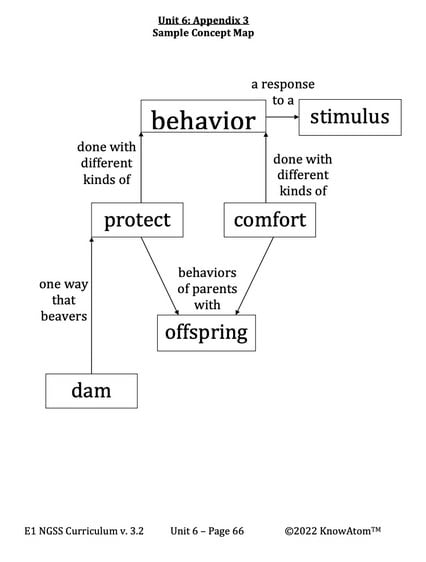In this lesson, students carry out an investigation to examine various animal parent behaviors depicted in different images and then categorize the behavior they observe.
In the last unit, students analyzed how engineers can mimic plant and animal structures to solve problems facing people. In this unit, students begin by exploring animal behaviors of parents and offspring that help the offspring survive. They then connect one specific behavior of beavers—building dams— with engineering, designing a dam that can stop the flow of water.
This page is a high-level extract of the first lesson which has students continuing to learn about animals, focusing on ways that offspring and their parents act to help the offspring survive. Students look for patterns in different behaviors to help them categorize the purpose of the behavior as protection, feeding, or comforting.
The science background provides teachers with in-depth information on the phenomena students investigate in the unit. It helps teachers understand the “why” and “how” of the topic being explored, in this case, parents and offspring behaviors.
In 2014, a team of Canadian researchers conducted an experiment in which they showed that wild mammals respond to the distress signals of infants of many different species. The experiment began when a biologist named Susan Lingle noticed that the infants of many mammal species have similar distress calls. These distress calls signal to adults that the infants need help of some kind.
Lingle wanted to know whether adults would respond to all of the infants’ cries, or just those of their own species. She and her team recorded the calls of infant deer, fur seals, dogs, cats, and humans. They then played those calls to wild mule deer and observed their behavior. A behavior is an organism’s response to a stimulus, which is anything in the environment that causes an organism to react.
The researchers found that the mother deer moved quickly toward the recordings of all of the infants. Jaak Panksepp, a scientist who wasn’t involved in the research, said the results are among the first to show that many mammals respond instinctively to the distress signals of other species. “They’re showing that these deer can perceive the emotional content of another animal’s separation call,” Panksepp told the New Scientist.
In this lesson, students carry out an investigation to examine various animal parent behaviors depicted in different images and then categorize the behavior they observe.

Prepared hands-on materials, full year grade-specific curriculum, and personalized live professional development designed to support mastery of current state science standards.
Comfort: to make another animal feel better
Dam: a special type of wall that holds back water, creating a reservoir
Offspring: the young born to living things
Protect: to keep safe from harm
Stimulus: anything in the environment that causes an organism to react
Feeding Babies
Many parents also have to feed their offspring. Babies communicate when they are hungry. Chicks make chirping sounds when they are hungry. Human babies cry. These sounds send their parents a message. The parents respond. They bring food to their offspring.
Comforting Babies
Some animals also comfort their offspring. To comfort means to make another animal feel better. Baby elephants sometimes feel nervous. They stick their trunks into the mouth of their mother. In response, the mother sometimes makes noises to comfort the baby.



For the hands-on activity in this lesson, students use photographic models to analyze different animal behaviors that help their offspring survive. Students work in teams to categorize eight different photographs according to the behaviors depicted in them. Once student teams reach consensus and complete the investigation, students come together as a class, presenting their analysis to the class and, guided by the teacher, respectfully critiquing the analysis of other teams.
KnowAtom incorporates formative and summative assessments designed to make students thinking visible for deeper student-centered learning.

Standards citation: NGSS Lead States. 2013. Next Generation Science Standards: For States, By States. Washington, DC: The National Academies Press. Neither WestEd nor the lead states and partners that developed the Next Generation Science Standards were involved in the production of this product, and do not endorse it.
